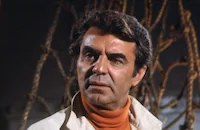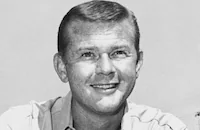Operation Pacific

Brief Synopsis
Cast & Crew
George Waggner
John Wayne
Patricia O'neal
Ward Bond
Scott Forbes
Philip Carey
Film Details
Technical Specs

Synopsis
At night, in a quiet bay in the South Pacific, submarine officer "Duke" Gifford watches as a group of children and nuns is loaded onto rafts and transported aboard the submarine Thunderfish . While the children, which include a newborn infant nicknamed "Butch," are fed, a Japanese aircraft carrier is sighted, and the crew springs to action. Although the American torpedoes hit the enemy ship, they fail to fire, and the Japanese, now alerted to the submarine's presence, attack.
The crew of the Thunderfish evades the enemy depth charges and sets course for Pearl Harbor. In the quiet that follows, Capt. "Pop" Perry asks Duke if he has heard from his ex-wife, Mary Stuart, who is now living in Honolulu. Duke reminisces about their divorce, blaming his dedication to work for the fact that he was at sea for both the birth and death of their son. After the Thunderfish arrives in port, Duke visits Butch at the hospital and by accident, encounters Mary, who is now a Navy nurse. The two still care deeply for each other, and share a passionate kiss, but when Duke asks if they can make a fresh start, Mary replies that she has a date with Navy pilot Bob Perry, Pop's brother.
Later, Duke, Pop, Mary and Bob encounter one another at same restaurant. Bob, who has always felt overshadowed by Duke's exploits, announces that he and Mary are engaged to be married. Although Mary admits that she has not actually consented, when Duke tries to force a confrontation, she leaves with Bob. Duke follows with flowers, and he and Mary talk about their marriage, but before he can finish, Duke is summoned to settle a dispute between some of his crew and a group of Hawaiians. After the conflict is resolved satisfactorily, the Thunderfish is sent back to sea, where the crew again experiences problems with defective torpedoes. Pop is invited to go ashore and help fix the problem, and recommends Duke to head the next patrol. Before they return to port, they spot an enemy freighter. When the torpedoes again fail to explode, the Japanese ship runs up a white flag.
Although he is puzzled by the action, Pop orders the submarine to surface and approach the vessel. The ship is a decoy, however, and opens fire on the Thunderfish . Although he knows he will not be able to get below deck in time, the wounded Pop orders the submarine to submerge. Then, under orders from the angry Duke, the crew rams the Japanese ship and sinks it. The crew heads home in their badly damaged submarine, and after a investigation, a service is held for Pop, whose body was never recovered. Bob believes that Duke gave the order to submerge and accuses him of trying to be a hero. Duke explains what really happened, but when Mary tries to sympathize with him, Duke rejects her efforts and adds that his only concern is keeping the crew of the Thunderfish together. After making his case to the commander, Duke and his men work to solve the torpedo problems and eventually achieve success with a new type of firing pin.
One day, Duke invites Mary to dinner, but she declines, explaining that their relationship is doomed to fail because he will not let her comfort him when things go wrong. Nursing commander Steele, having overheard the conversation, advises Mary to take Duke as he is. Mary and Duke's problems are still unresolved when the Thunderfish again puts to sea. While tracking down the source of some major explosions, the crew happens upon the Japanese fleet heading for Leyte. Although it will put themselves in great danger, Duke orders the radio man to alert the American forces. They then fire all available torpedoes and, while battered by depth charges, destroy an aircraft carrier. After the U.S. attack begins, Thunderfish is asked to help rescue downed flyers. Under attack from Japanese planes, the men enact the rescues, and Duke is wounded while rescuing Bob. When they again dock in Pearl Harbor, Mary is waiting for Duke, and together they head for the hospital to adopt Butch.

Director

George Waggner
Cast

John Wayne
Patricia O'neal

Ward Bond

Scott Forbes

Philip Carey

Paul Picerni

Bill Campbell
Katherine Givney

Martin Milner
Cliff Clark
Jack Pennick
Virginia Brissac
Vincent Fotre
Lewis Martin
Sam Edwards
Louis Mosconi
Gayle Kellogg
Steve Wayne
Bob Nash
Bill Self
Bob Strong
Eric Hoeg
Carl Saxe

James Flavin
Al Kikume

Bob Carson
Ray Hyke
Chris Drake
Vera Burnett
Harry Lauter
Carlton Young

Harlan Warde
John Baer
Crew
Gordon Bau
Alan Crosland Jr.
Murray Cutter
Louis F. Edelman
Bert Glennon
Ray Heindorf
John Gilbert Kissel
H. F. Koenekamp
Leo K. Kuter
Vice Admiral Charles Lockwood Usn (ret.)
William Mcgann
Russell Saunders
Francis J. Scheid
Max Steiner
George Waggner
George Waggner

Videos
Movie Clip



Trailer
Hosted Intro
Film Details
Technical Specs

Articles
Operation Pacific
Though Neal and Wayne would later re-team for Otto Preminger's In Harm's Way (1965) - where Wayne once again plays a Navy officer in the Pacific and Neal once again plays a Navy nurse! - there was little chemistry between them on the set of Operation Pacific. According to Neal: "John Wayne had enormous appeal for the public, but I did not find him appealing in the least. I think my charms were lost on him too." But while the romantic subplot may have been a fiction (Neal was at the time involved with Gary Cooper), the events on board the fictional submarine, the Thunderfish, were loosely based on historical exploits of the submarine fleet, otherwise known as the "silent service."
For instance, in the film, Commander John T. Perry (played by Wayne's old friend and frequent co-star, Ward Bond) sacrifices himself to save his ship and crew when he bravely orders the Thunderfish to descend, knowing he will be stranded above deck. The incident seems melodramatic, but is, in fact, based on the real-life heroism of Howard W. Gilmore, commander of the submarine tender USS Growler. In the early morning hours of February 7, 1943, the Growler approached a Japanese gunboat. The small ship quickly turned and started on a collision course with the sub. Commander Gilmore brilliantly maneuvered his ship so as to ram the gunboat, seriously damaging the Growler in the process. Then, according to the official citation:
"In the terrific fire of the sinking gunboat's heavy machine guns, Commander Gilmore calmly gave the order to clear the bridge, and refusing safety for himself, remained on deck while his men preceded him below. Struck down by the fusillade of bullets and having done his utmost against the enemy, in his final living moments Commander Gilmore gave his last order to the officer of the deck, 'Take her down!'"
Gilmore's sacrifice earned him a posthumous Medal of Honor and, the following year, the Navy named a submarine after him. Interestingly, Ward Bond played a part in another telling of this story. In 1957, John Ford directed The Growler Story, a short promotional film for the Navy. This time, Ken Curtis (Ford's son-in-law) played Gilmore while Bond played one of the officers.
Operation Pacific was written and directed by George Waggner, whose association with Wayne went back some 15 years. Not only did he write and direct Wayne's frontier drama, The Fighting Kentuckian (1949), he also wrote (or co-wrote) three of Wayne's minor films from the 1930s: Sea Spoilers (1936), Idol of the Crowds (1937), and I Cover the War (1937). Despite this history, Patricia Neal reports that "Duke was at odds with the director" during the shooting of Operation Pacific. The movie was shot by Bert Glennon, who was also the cinematographer on such notable John Ford films as Stagecoach (1939) and Young Mr. Lincoln (1939). Glennon also shot Warner Brothers' earlier submarine film, Destination Tokyo (1943), footage of which was re-used in Operation Pacific.
A very young Martin Milner (from TV's Adam-12) plays the role of Ensign Caldwell. And if the voice of the Alabama crewman known as Junior sounds familiar, it may be because he provided the voice of the adult Thumper in Bambi (1942).
Producer: Louis F. Edelman
Director/Screenplay: George Waggner
Art Direction: Leo K. Kuter
Cinematography: Bert Glennon
Film Editing: Alan Crosland Jr.
Original Music: Max Steiner
Principal Cast: John Wayne (Lt. Commander Duke E. Gifford), Patricia Neal (Mary Stuart), Ward Bond (Commander John T. "Pop" Perry), Scott Forbes (Lt. Larry), Philip Carey (Lt. Bob Perry), Paul Picerni (Jonesy), William Campbell (The Talker), Martin Milner (Ensign Caldwell).
BW-110m. Closed captioning.
by Mark Frankel

Operation Pacific
Quotes
How's the picture?- Lcdr. Duke E. Gifford, Executive Officer Thunderfish
Oh, alright I guess, sir... the things those Hollywood guys can do with a submarine.- Lt. Larry
Take her down!- 'Pop' Perry
Trivia
Notes
The film begins with the following written foreword: "When the Pacific Fleet was destroyed by the Japanese sneak attack on Pearl Harbor, it remained for the submarines to carry the war to the enemy. In the four years that followed our undersea craft sank six million tons of Japanese shipping including some of the proudest ships of the imperial navy. Fifty-two of our submarines and thirty-five hundred men were lost. It is to these men and the entire silent service that this picture is humbly dedicated." It ends with with the following statement: "To the United States Navy for its aid and cooperation in making this picture possible our grateful thanks." George Waggner's onscreen credit reads: "Written and directed by George Waggner." This film marked the first screen appearance of actor Philip Carey. Operation Pacific received a merit citation from the Southern California Motion Picture Council.

Miscellaneous Notes
Released in United States on Video May 13, 1992
Released in United States Winter January 27, 1951
Released in United States Winter January 27, 1951
Released in United States on Video May 13, 1992















